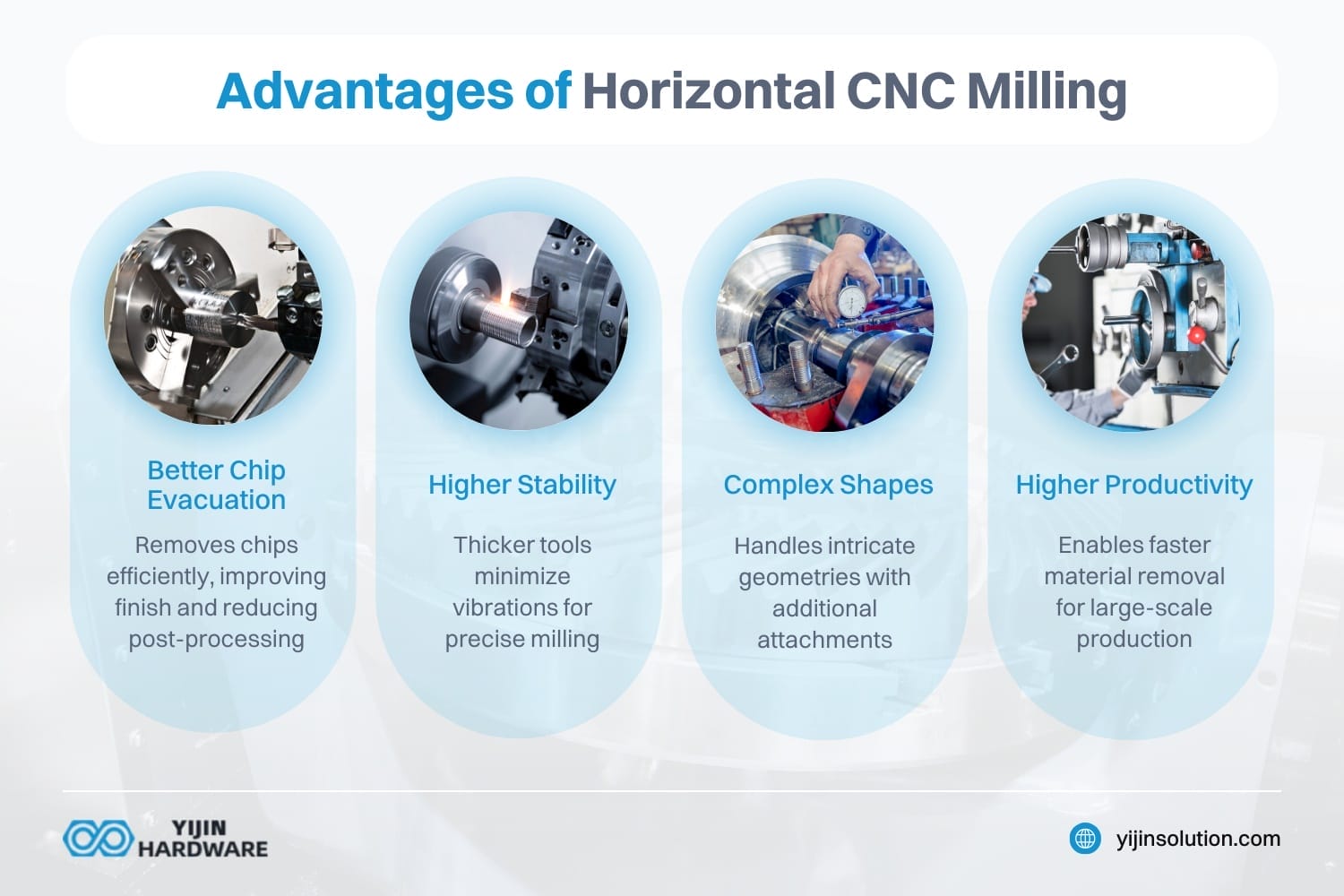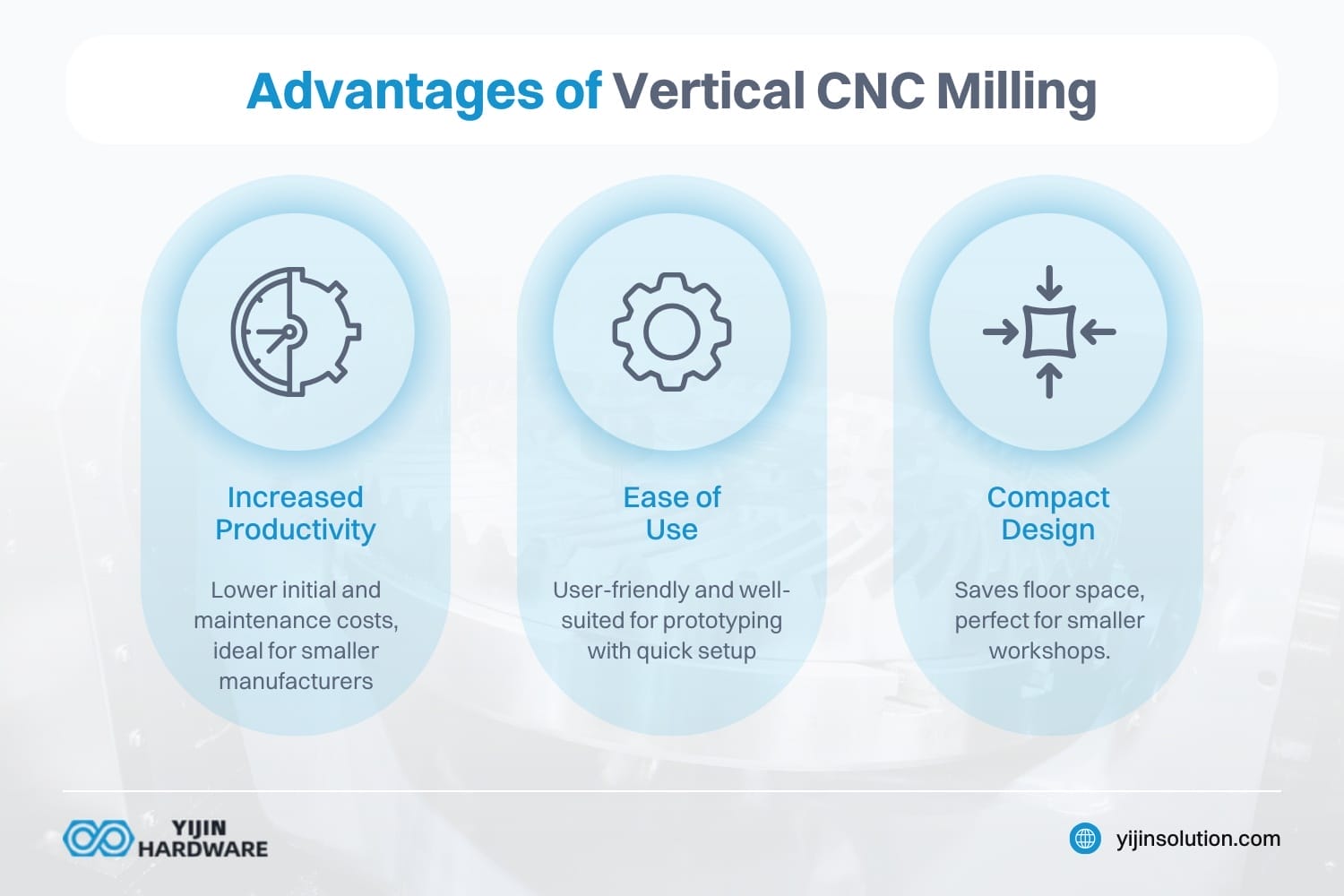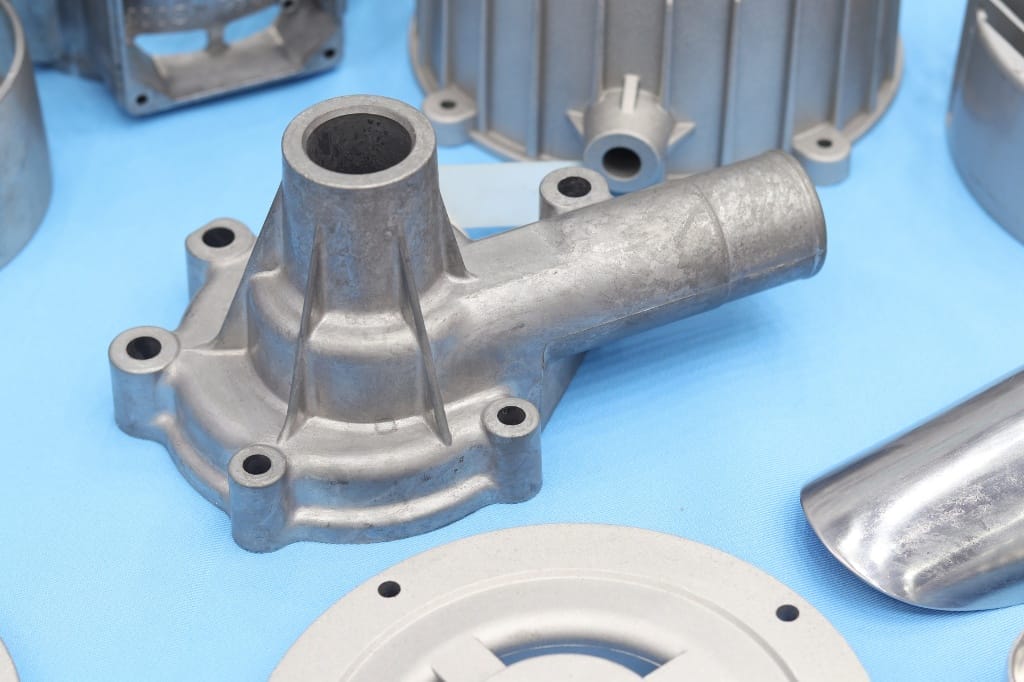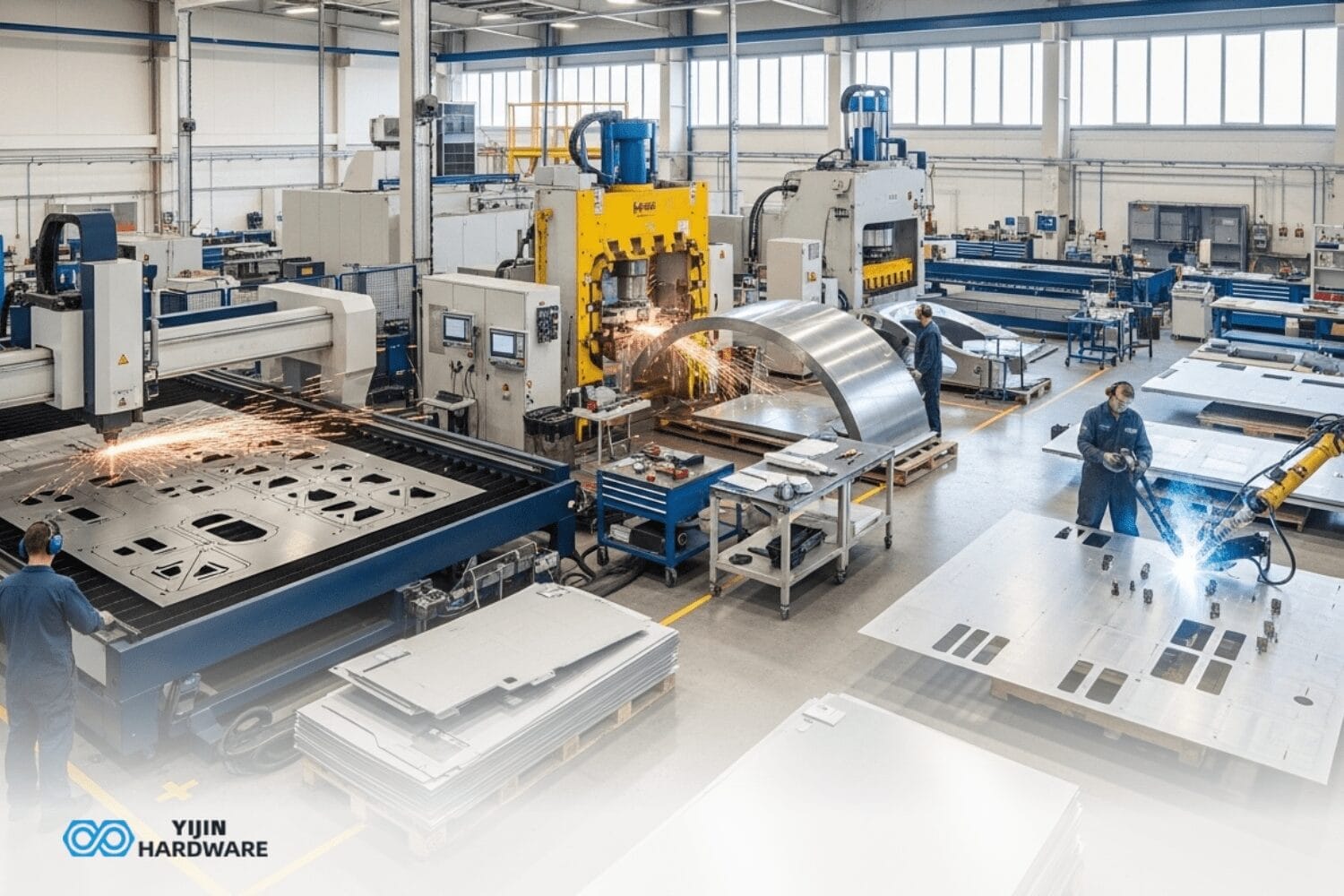Horizontal and vertical CNC milling machines differ primarily in spindle orientation: horizontal spindles run parallel to the worktable, while vertical spindles run perpendicular to it. Horizontal and vertical CNC milling are two primary types of machining processes used in manufacturing. Their fundamental differences affect cutting capabilities, workpiece accessibility, and suitable applications.
Your choice between these two milling types significantly impacts production efficiency, part quality, and manufacturing costs. Luckily, Yijin Hardware specializes in providing both vertical and horizontal CNC milling services, catering to a wide range of manufacturing needs by leveraging the latest CNC technology.
Key Takeaways
- Horizontal and vertical CNC milling machines differ in spindle orientation — horizontal spindles run parallel to the worktable for side‑cutting operations with superior chip evacuation and stability, while vertical spindles run perpendicular for top‑down access and finer detailing.
- Horizontal milling delivers more efficient material removal rates, deeper cuts, and multi‑side machining for high‑volume production but comes with greater initial cost and training needs, whereas vertical milling is more affordable, user‑friendly, and space‑efficient, making it ideal for prototyping and small‑batch, detailed work.
- Choosing between the two hinges on production volume, lead times, and budget, as each orientation uniquely impacts efficiency, part quality, and overall manufacturing costs.
What is Horizontal CNC Milling and How does it Work?
Horizontal CNC milling machines feature cutting tools mounted on a horizontally-oriented spindle that runs parallel to the workpiece surface. These machines utilize shorter, thicker cutting tools that rotate around a horizontal axis to remove material from the stationary workpiece.
The horizontal orientation allows for side-cutting operations where the tool approaches the workpiece from the side rather than from above. Approaching the workpiece from the side enables more efficient machining of complex geometries and deeper cuts.
Advantages of Horizontal CNC Milling

- Better Chip Evacuation: Horizontal orientation throws chips away from the workpiece, resulting in a smoother finish and reduced post-processing needs. Making chip evacuation more efficient is particularly beneficial in a machine shop setting where efficiency is crucial.
- Higher Stability: Thicker tools minimize vibrations, ensuring more accurate cuts. Harnessing and maximizing stability is essential for maintaining precision in milling operations.
- Complicated Shapes: Horizontal CNC milling is capable of handling tough geometries with additional attachments. The added versatility allows horizontal CNC milling to be used in a wide range of applications, not just standard shapes.
- Higher Productivity: Achieves faster material removal rates and deeper cuts, making it ideal for large-scale production. According to Mastercam, horizontal mills are definitely preferred for large quantities or more intricate parts.
Disadvantages of Horizontal CNC Milling
- Expensive: Larger initial and maintenance costs compared to vertical machines. While this may be a significant factor for smaller operations with limited budgets,
- Operator Training: Harder to find trained operators due to the machine’s scarcity. Scarcity can lead to increased labor costs and training requirements.
Understanding Vertical CNC Milling
Vertical CNC milling machines feature a spindle mounted perpendicular to the worktable, with the cutting tool extending downward into the material. The orientation mimics the natural human perspective of working from above, making these machines more intuitive to operate and monitor.
There are two main types of vertical milling machines, turret mills and bed mills:
How do Turret Mills Work?
In turret milling machines, the spindle remains stationary while the bed moves both horizontally and vertically. The design allows for precise control of the workpiece position, making turret mills particularly effective for manufacturing parts with multiple cavities, molds, and components requiring precise boring operations. The bed’s movement provides flexibility for creating detailed features on smaller workpieces.
How do Bed Mills Work?
Bed milling machines, in contrast to turret mills, feature a fixed bed with a spindle that moves vertically while the table moves horizontally. This configuration provides greater stability for larger workpieces, as the bed remains stationary during machining operations. The worktable slides along the horizontal axis while the spindle adjusts height, allowing for efficient face milling, slotting, and drilling operations.
The cutting tools in vertical machines are generally longer and thinner than those used in horizontal machines, allowing for precise detailing but limiting depth of cut and material removal rates.
Advantages of Vertical CNC Milling

- Cost-Effective: Lower upfront and maintenance costs compared to horizontal machines. Vertical milling is more accessible to smaller manufacturers.
- Ease of Use: Generally more user-friendly and suitable for prototyping. The simplicity of vertical machines allows for quicker setup and operation.
- Compact Design: Requires less floor space, making it ideal for smaller shops. The compactness of vertical milling is beneficial in environments where space is limited.
Disadvantages of Vertical CNC Milling
- Limited Flexibility: Vertical milling is not suitable for large-scale production or complicated geometries. The limitation restricts its use in high-volume manufacturing environments.
- Chip Removal: Chips accumulate on the workpiece, requiring manual removal. This can increase labor costs and reduce efficiency.
Choosing Between Horizontal and Vertical CNC Milling
When deciding between horizontal and vertical CNC milling, several factors should be considered, such as production volume and material type. Other elements that may influence you to choose one over the other are the impact on lead times, which can be affected by how difficult your CNC milling machine is to operate.
| Feature | Horizontal Milling | Vertical Milling |
|---|---|---|
| Spindle Orientation | Parallel to worktable | Perpendicular to worktable |
| Initial Cost | Substantially more | Lower entry point |
| Material Removal Rate | Higher (3-4 times faster) | Lower |
| Tool Geometry | Short, thick tools | Long, thin tools |
| Chip Evacuation | Natural gravity assistance | Manual/coolant assistance required |
| Multi-side Machining | Multiple sides in single setup | Typically 1–2 sides per setup |
| Floor Space Required | Larger footprint | More compact design |
| Operator Training | More extensive training needed | Simpler learning curve |
| Tool Life | Longer due to better chip evacuation | Shorter due to chip recutting |
| Ideal Production Volume | Greater volume production | Lower volume, varied work |
| Setup Time | Longer initial setup | Quicker changeovers |
| Fixture Complexity | Higher (tombstone fixtures) | Lower (standard vises) |
| Best Application | Multi-sided parts | Single-faced, detailed work |
Which Industries Benefit Most from Horizontal CNC Milling?
Aerospace, automotive, and heavy equipment industries benefit the most from using a horizontal CNC milling machine. While these aren’t the only industries that rely on this type of CNC milling, we’ve outlined why and how these three prefer horizontal milling over vertical.
How does the Aerospace Industry Use Horizontal Mills?
The aerospace industry needs horizontal milling for several of its manufacturing structural components. These include engine parts and landing gear assemblies. The ability to machine difficult to make geometries with tight tolerances makes horizontal mills essential for producing components from difficult materials like titanium alloys and Inconel.
Horizontal machines allow for machining large monolithic structures, reducing part count and weight while improving structural integrity — critical factors in aircraft manufacturing.
Why do Automotive Manufacturers Prefer Horizontal Mills Instead of Vertical Milling?
Automotive production facilities utilize horizontal milling machines for high-volume manufacturing of engine blocks, transmission cases, and structural components. The superior material removal rates reduce cycle times compared to vertical machines when producing components like cylinder heads, where multiple surfaces must be machined to precise specifications.
For large production runs, horizontal mills typically deliver cost savings despite a larger initial investment.
How do Heavy Equipment Manufacturers Benefit from Horizontal Milling?
The heavy equipment industry leverages horizontal milling for large components like hydraulic manifolds, gear housings, and structural frames. These machines efficiently handle large steel castings and forgings while maintaining positioning accuracy across large work envelopes. The ability to perform heavy cutting operations significantly reduces production time for massive components.
Which Industries Benefit Most from Vertical CNC Milling?
The medical industry, electronics manufacturing, and even tool and die shops benefit greatly from vertical CNC milling. Most electronics and tool shops require single-faced detailed work that vertical CNC milling excels at. Some medical devices will benefit more from horizontal milling, but many products still are manufacturable using vertical milling.
How do Medical Device Manufacturers Use Vertical Mills?
The medical device industry is extremely reliant on vertical milling machines for producing precision components like orthopedic implants, surgical instruments, and diagnostic equipment parts. The direct visibility and precise control offered by vertical machining centers enables manufacturers to achieve the surface finishes and tight tolerances required for medical applications. For specialized components produced in smaller quantities, vertical mills provide the ideal balance of precision and cost-effectiveness.
Why are Vertical Mills Popular in Electronics Manufacturing?
Electronics manufacturers use vertical milling machines to produce heat sinks, chassis components, and precision fixtures. The ability to create fine details and maintain tight tolerances makes vertical mills ideal for machining aluminum enclosures and heat management components. For prototype development and small production runs common in consumer electronics, vertical machines offer faster turnaround times due to simpler setup procedures and more intuitive programming.
Do Tool and Die Shops Benefit from Vertical Mills?
Yes, tool and die shops leverage vertical milling machines as well. The excellent visibility and precise control enable craftsmen to achieve the fine details and surface finishes required for injection molds and stamping dies. For shops handling diverse, small-batch projects, vertical mills provide greater versatility across different job types while requiring less capital investment than comparable horizontal machines.
Yijin Hardware offers comprehensive CNC machining services, including both vertical and horizontal milling. Our expertise ensures that you can choose the right machine for your specific needs, whether it’s high-volume production or precision work. By leveraging the latest CNC technology and understanding the differences between horizontal and vertical milling, we provide tailored solutions to support your manufacturing goals.
Contact us today to explore how our services can optimize your production processes and help you select the right milling machine for your project.
Horizontal Vs Vertical Milling FAQs
What are the main components of a horizontal milling machine?
A horizontal milling machine consists of a horizontal axis, spindle, and horizontal beam. The horizontal cutters throw chips outward during the milling process for efficient material removal. This machine tool provides stability for heavy-duty machining, especially for large workpieces. Compared to its vertical counterparts, it offers advantages and disadvantages of CNC machining based on application needs.
What are the types of milling machines?
Milling machines come in various forms, including vertical milling, horizontal mill vs. vertical milling, and bed milling machines. Choosing between vertical and horizontal options depends on the type of machining center required. A vertical knee mill features a vertical head, whereas a horizontal setup supports heavy-duty cutting. The differences between vertical and horizontal milling machines impact speed, precision, and flexibility.
Is a 5-Axis mill essentially a combination of the two?
A 5-axis mill integrates horizontal or vertical movements with rotational capabilities for machining. It surpasses both CNC vertical machining and horizontal configurations by allowing multi-directional cutting. CNC vertical milling setups alone lack the additional tilting and rotating motion needed for intricate work. The combination of axes in a 5-axis system enhances efficiency and reduces repositioning needs.
Is it impossible to do a plain milling operation on a vertical milling machine and face milling on horizontal milling machines?
It is not impossible, but each machine has a more suitable function for specific tasks. A CNC vertical setup can perform plain milling, but is less efficient than a horizontal milling process. Likewise, a horizontal milling setup can handle face milling, though CNC vertical machining centers are more commonly used. The milling process depends on the horizontal or vertical orientation of the workpiece and tooling.
Back to Top: Horizontal Vs Vertical CNC Milling | Differences Explained









